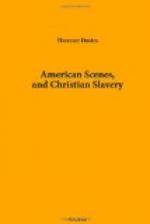We are still looking at these churches. The church on our right, which is about the same size and of the same architectural character as the other, though not quite so showy, is the “second” Congregational Church, commonly called the North Church—that in which Mr. Button now ministers. This church originated in the “great awakening” in 1740, was formed in 1742, and has a history of more than a century in duration. It arose from dissatisfaction with the ministry of a Mr. Noyes, a contemporary of Jonathan Edwards, but one who had no sympathy in Edwards’s views and spirit. This man was, indeed, greatly opposed to the “awakening,” and refused George Whitfield admission to his pulpit. The originators of this second church, therefore, separated from the original parent, availed themselves of the Act of Toleration, and became Congregational Dissenters from a Congregational Establishment! They had of course no State support, nor were they “free from taxation by the society from which they dissented.” “The foundations of this church, my brethren,” said its present gifted pastor, in a sermon preached at the centenary of its formation, “are love of evangelical doctrine, of ecclesiastical liberty, of revivals of religion. Such ever be its superstructure.”
Here, for a quarter of a century, lived and laboured Jonathan Edwards the younger. Perhaps you have never before heard of him; neither had I till I came to New Haven. If you won’t think it too long to be detained here standing in front of the church, I will tell you a few facts respecting him. He was the second son and ninth child of the celebrated Jonathan Edwards of Northampton. His mother, too, was an extraordinary woman. You will smile at the impression she made on the mind of good old George




